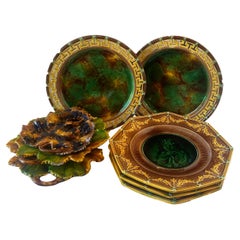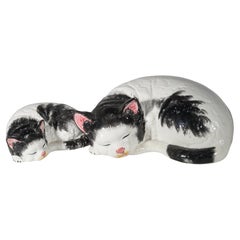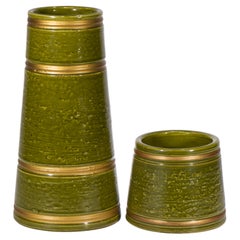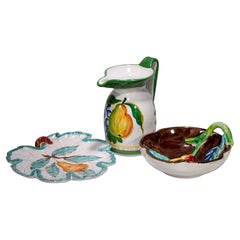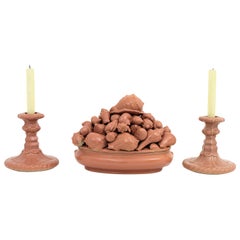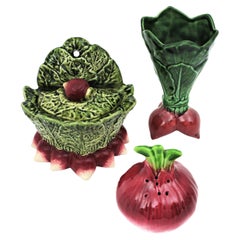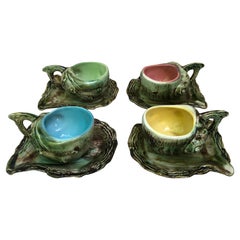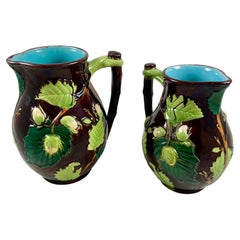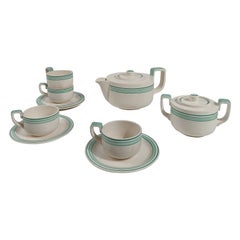Set Of Majolica
20th Century English Porcelain
Clay
Mid-20th Century Italian Mid-Century Modern Animal Sculptures
Ceramic, Majolica, Pottery
Mid-20th Century Italian Mid-Century Modern Vases
Gold
Mid-20th Century Italian Mid-Century Modern Vases
Ceramic, Majolica, Pottery, Terracotta
20th Century French Soup Tureens
Majolica, Ceramic
20th Century Portuguese Mid-Century Modern Ceramics
Ceramic, Majolica
Vintage 1950s French Mid-Century Modern Tea Sets
Ceramic, Faience
Antique Late 19th Century English Aesthetic Movement Pitchers
Earthenware
Vintage 1930s Art Deco Tea Sets
Majolica
20th Century American High Victorian Tea Sets
Ceramic, Paint
Antique 19th Century American Dinner Plates
Porcelain
Antique Early 1900s French Mid-Century Modern Tea Sets
Ceramic
Antique 19th Century French Rococo Dinner Plates
Majolica
Antique 18th Century Italian Ceramics
Majolica
Antique Early 1900s French Country Dinner Plates
Majolica, Porcelain
Vintage 1930s German Pottery
Majolica
Vintage 1930s Italian Dinner Plates
Majolica
Vintage 1930s Italian Dinner Plates
Majolica
Antique 1890s French Art Nouveau Antiquities
Ceramic, Majolica
Antique Late 19th Century French French Provincial Pottery
Majolica
Vintage 1960s French French Provincial Dinner Plates
Ceramic, Majolica
Vintage 1960s French French Provincial Dinner Plates
Ceramic, Majolica
Antique Late 19th Century English Ceramics
Majolica
Antique 19th Century French Dinner Plates
Enamel
Vintage 1960s French French Provincial Dinner Plates
Ceramic, Majolica
Antique 19th Century English Platters and Serveware
Vintage 1930s French Art Deco Planters and Jardinieres
Majolica, Ceramic
Antique 1850s Austrian Art Nouveau Platters and Serveware
Ceramic, Faience, Majolica
Early 20th Century Belgian Art Nouveau Ceramics
Ceramic, Faience, Majolica, Pottery
Early 20th Century French Delft and Faience
Majolica
Antique Late 19th Century Italian Renaissance Revival Delft and Faience
Ceramic, Majolica
Antique 19th Century French Dinner Plates
Faience, Ceramic, Majolica
Vintage 1930s French Platters and Serveware
Majolica
Antique 1890s French Rustic Dinner Plates
Ceramic, Faience, Majolica
Antique 1890s French Art Nouveau Dinner Plates
Ceramic, Majolica
Early 20th Century Italian Renaissance Revival Platters and Serveware
Majolica
Antique 19th Century French French Provincial Dinner Plates
Ceramic, Majolica
Antique 19th Century French Dinner Plates
Faience, Majolica, Paint
Mid-20th Century French French Provincial Platters and Serveware
Majolica
Antique 19th Century French Dinner Plates
Majolica
Mid-20th Century Italian Ceramics
Gold
Mid-20th Century French Mid-Century Modern Serving Bowls
Majolica, Pottery, Ceramic
Antique Early 19th Century French French Provincial Dinner Plates
Porcelain
Antique 1890s French Victorian Dinner Plates
Ceramic, Majolica
20th Century Portuguese American Classical Ceramics
Ceramic
Antique 19th Century French French Provincial Platters and Serveware
Ceramic, Majolica
Antique 19th Century French Ceramics
Majolica
Antique 19th Century French Ceramics
Majolica
Vintage 1960s French French Provincial Dinner Plates
Ceramic, Majolica
Antique 1880s French Art Nouveau Planters, Cachepots and Jardinières
Ceramic, Majolica
Vintage 1930s French Art Nouveau Ceramics
Majolica
Antique Mid-19th Century English Aesthetic Movement Dinner Plates
Earthenware, Majolica, Pottery
Early 20th Century French Provincial Dinner Plates
Majolica
20th Century Italian Mid-Century Modern Soup Tureens
Majolica, Pottery, Ceramic
Vintage 1920s French Art Nouveau Dinner Plates
Ceramic, Majolica
Antique 19th Century French Dinner Plates
Enamel
Vintage 1950s French French Provincial Platters and Serveware
Ceramic
- 1
Set Of Majolica For Sale on 1stDibs
How Much is a Set Of Majolica?
Finding the Right Dining-entertaining for You
Your dining room table is a place where stories are shared and personalities shine — why not treat yourself and your guests to the finest antique and vintage glass, silver, ceramics and serveware for your meals?
Just like the people who sit around your table, your serveware has its own stories and will help you create new memories with your friends and loved ones. From ceramic pottery to glass vases, set your table with serving pieces that add even more personality, color and texture to your dining experience.
Invite serveware from around the world to join your table settings. For special occasions, dress up your plates with a striking Imari charger from 19th-century Japan or incorporate Richard Ginori’s Italian porcelain plates into your dining experience. Celebrate the English ritual of afternoon tea with a Japanese tea set and an antique Victorian kettle. No matter how big or small your dining area is, there is room for the stories of many cultures and varied histories, and there are plenty of ways to add pizzazz to your meals.
Add different textures and colors to your table with dinner plates and pitchers of ceramic and silver or a porcelain lidded tureen, a serving dish with side handles that is often used for soups. Although porcelain and ceramic are both made in a kiln, porcelain is made with more refined clay and is more durable than ceramic because it is denser. The latter is ideal for statement pieces — your tall mid-century modern ceramic vase is a guaranteed conversation starter. And while your earthenware or stoneware is maybe better suited to everyday lunches as opposed to the fine bone china you’ve reserved for a holiday meal, handcrafted studio pottery coffee mugs can still be a rich expression of your personal style.
“My motto is ‘Have fun with it,’” says author and celebrated hostess Stephanie Booth Shafran. “It’s yin and yang, high and low, Crate & Barrel with Christofle silver. I like to mix it up — sometimes in the dining room, sometimes on the kitchen banquette, sometimes in the loggia. It transports your guests and makes them feel more comfortable and relaxed.”
Introduce elegance at supper with silver, such as a platter from celebrated Massachusetts silversmith manufacturer Reed and Barton or a regal copper-finish flatware set designed by International Silver Company, another New England company that was incorporated in Meriden, Connecticut, in 1898. By then, Meriden had already earned the nickname “Silver City” for its position as a major hub of silver manufacturing.
At the bar, try a vintage wine cooler to keep bottles cool before serving or an Art Deco decanter and whiskey set for after-dinner drinks — there are many possibilities and no wrong answers for tableware, barware and serveware. Explore an expansive collection of antique and vintage glass, ceramics, silver and serveware today on 1stDibs.
- What is Italian majolica?1 Answer1stDibs ExpertApril 5, 2022Majolica refers to tin-glazed pottery that features a white background with brightly colored hues painted on top. The colors are applied as underglazes or to the unfired glaze and then fired to hold them in place forever. This technique was widely used in the Renaissance period in northern and central Italy. Shop a range of antique and vintage majolica on 1stDibs.
- Is majolica a pottery?1 Answer1stDibs ExpertApril 5, 2022Yes, majolica is a type of pottery. Artisans produce it from a heavy clay with a rich brown color and then finish it with enamel, paint and glaze. The style of pottery emerged during the mid 19th century. Find a variety of majolica pottery on 1stDibs.
- What is a majolica jardiniere?1 Answer1stDibs ExpertApril 5, 2022A majolica jardiniere is an ornamental stand for holding planters and flower pots that is made out of a type of earthenware pottery called majolica. It has a high-gloss finish and vibrant colors achieved through the use of lead glaze. Shop a selection of jardinieres on 1stDibs.
- What is a majolica print?1 Answer1stDibs ExpertFebruary 17, 2023A majolica print is a print used on textiles, apparel and accessories that draws inspiration from majolica tin-glazed pottery produced during the Italian Renaissance. Often, the prints incorporate intricate scrollwork, fruit and flowers and show off vibrant blue, orange and yellow colors. Shop a variety of apparel and accessories on 1stDibs.
- What is antique majolica?1 Answer1stDibs ExpertApril 5, 2022Antique majolica is a type of Victorian earthenware characterized by beautifully-colored lead glazes. It first appeared in the 1850s and is highly sought after today. On 1stDibs, shop a collection of antique majolica from some of the world’s top sellers.
- What is a majolica plate?1 Answer1stDibs ExpertApril 5, 2022A majolica plate is a decorative piece of pottery that has a round flat shape. It is a heavy clay vessel that features a painted and glazed enamel finish. It emerged from 15th-century Italy but quickly became popular in Spain. Later examples come from Victorian England. On 1stDibs, shop a selection of majolica plates.
- What is Minton Majolica?1 Answer1stDibs ExpertApril 5, 2022Minton Majolica is a type of glazing process for pottery. Created at the Minton factory in London, Majolica is a low-temperature, colored lead glaze used on earthenware pottery. You’ll find a selection of antique Milton Majolica pieces from some of the world’s top dealers on 1stDibs.
- What is Palissy majolica?1 Answer1stDibs ExpertApril 5, 2022Palissy majolica is a combination of terms. Famed French potter Bernard Palissy’s ceramics were known as rusticware to him, but his novel polychrome lead-glazed look with naturalistic scenes were so highly regarded that the style became known as Palissyware. Centuries later, in the Palissy style, Minton & Co. created their Palissy ware, which later became known as majolica. Find a collection of expertly vetted Palissy art from some of the world’s top reputable boutiques on 1stDibs.
- 1stDibs ExpertApril 5, 2022There is no difference between maiolica and majolica pottery, they are simply variations of the same name. Majolica/maiolica is earthenware with a tin-glazed white enamel finish that was made in Italian. Other names for tin-glazed pottery are faience or delftware. Shop a large selection of Italian pottery on 1stDibs.
- 1stDibs ExpertOctober 7, 2024The difference between majolica and faience is largely a matter of geography and style. Both terms describe types of tin-glazed earthenware inspired by maiolica, ceramics made in Italy beginning in the 15th century. Majolica is the British take on maiolica. It emerged during the mid-19th century. Made by Minton and other companies, it is often playful and whimsical. Think of a sardine jar adorned with decorative sardines or a pie dish that resembles a real pie. Faience is the French version of maiolica. Artisans began producing it in the 16th century in the city of Rouen. However, it became especially popular during the late 19th century. Unlike the creative designs common among majolica pottery, faience tends to be more formal and draws inspiration from Persian, Japanese and Chinese ceramics. Explore a collection of majolica and faience pottery on 1stDibs.
- Is majolica worth anything?1 Answer1stDibs ExpertOctober 24, 2024Yes, some majolica is worth something. Many collectors seek out select pieces from well-known makers of tin-glazed earthenware, such as Wedgwood, George Jones and Minton, and rare items can sometimes sell for thousands of dollars. However, selling prices for majolica vary greatly based on age, type, style, condition and other factors. A certified appraiser or knowledgeable antique dealer can help you determine how much any pottery you own is worth. Shop a large selection of majolica pottery on 1stDibs.
- 1stDibs ExpertOctober 7, 2024To know if your majolica is real, examine the glaze carefully. Authentic majolica will usually be free of flaws, while reproductions may display runs and drips. Keep in mind that majolica is a type of earthenware rather than a brand. Familiarizing yourself with the maker's marks and characteristics of the pieces associated with the artisan or factory that produced your pottery can help you determine what else to look for during the authentication process. If you'd like a professional opinion, consult a certified appraiser or knowledgeable antique dealer. On 1stDibs, explore a range of majolica pottery.
- 1stDibs ExpertNovember 4, 2024One of the easiest ways to identify vintage majolica is to use the maker's marks. Look at the bottom and interior of your piece and then consult trusted online resources to determine if it was produced by a maker well-known for making majolica, such as Wedgwood, Minton or George Jones. Once you have identified the maker, research further to determine the approximate age of your piece. You can consider it vintage if it is 20 to 99 years old. Alternatively, you can ask a certified appraiser or experienced antique dealer to evaluate your piece. On 1stDibs, explore an assortment of vintage majolica pottery.
- 1stDibs ExpertAugust 20, 2024The difference between majolica and talavera comes down to specificity. Majolica is the term for earthenware pottery finished with a specialty tin glaze. Talavera is a type of majolica that originated in the Talavera de la Reina area of Spain and later spread to Mexico. It typically features intricate, colorful floral patterns. Shop a selection of majolica and talavera pottery on 1stDibs.
- 1stDibs ExpertApril 5, 2022To tell if majolica is real, look closely at the glazed finish. If you notice uneven coloration, drips, runs or other imperfections, the pottery is unlikely to be authentic. On 1stDibs, you can shop a range of expertly vetted majolica pottery.
- 1stDibs ExpertApril 5, 2022Majolica pottery comes primarily from Italy, Mexico and Spain. The earliest examples of the glazed pottery originate from Italy and date back to the Renaissance. By the 19th century, many workshops in Europe produced majolica pieces. On 1stDibs, shop a selection of majolica pottery.
- Is Bordallo majolica pottery?1 Answer1stDibs ExpertMarch 25, 2024Yes, Bordallo is majolica pottery. Majolica is the term for pottery that features a tin glaze and colorful details hand-painted on a white background. Bordallo Pinheiro is well known for using traditional Portuguese techniques to produce pottery in the majolica style. On 1stDibs, find a selection of Bordallo Pinheiro pottery.
- What is a wedding set?1 Answer1stDibs ExpertNovember 2, 2021A wedding set is a set of three rings, namely an engagement ring and a pair of matching wedding bands for the betrothed. In some cases, the groom's ring is excluded and it’s called a bridal set. Shop a collection of vintage and modern wedding ring sets from some of the world’s top jewelers on 1stDibs.
- What is a dinette set?1 Answer1stDibs ExpertOctober 19, 2021A dinette set is a smaller dining table with matching seating for a smaller space or smaller kitchen. They are less formal than dining table sets. They are usually used in kitchens as eat-in tables. On 1stDibs, find a variety of antique and vintage dinette sets.
- What is a bath set?1 Answer1stDibs ExpertOctober 5, 2021A bath set is a coordinated range of bathroom accessories that include ceramic, metal, stone or plastic sets that comprise a liquid soap dispenser, soap dish, tumbler, a toothbrush holder and a tray. But it can also include matching buckets, dustbins and maybe even bathroom fittings. On 1stDibs you can source vintage and contemporary bath sets and accessories in ceramic, silver and stone.
Read More
How a Craving for Color Revolutionized Glass
After synthetic dyes changed fashion, home goods and printed matter, it was only a matter of time till glass caught up.
1882 Ltd. Looks to the Future of Ceramics in the U.K. with an Eclectic Exhibition and Auction
Faye Toogood and John Pawson are among the list of plate designers.
20 Inviting Dining Rooms Perfectly Arranged for Entertaining
Top interior designers show — and tell — us how to create delectable spaces for hosting dinner parties.
Paul Revere Crafted This Silver Coffee Pot 250 Years Ago
Perhaps best known as a Revolutionary War hero, Revere was also an accomplished silversmith, and this pot is now available on 1stDibs.
From Arne Jacobsen to Zaha Hadid, Top Designers Tackle Tableware
Clever objects like these make feasting even more festive.
How the Chunky, Funky Ceramics of 5 Mid-Century American Artists Balanced Out Slick Modernism
Get to know the innovators behind the pottery countercultural revolution.
Ready for a Cinderella Moment? This Glass Handbag Is a Perfect Fit
Glass slippers might be the stuff of fairytales, but glass handbags? Artist Joshua Raiffe has made them a reality, and they're far less delicate than you might imagine, but just as dreamy.
With Dansk, Jens Quistgaard Delivered Danish Simplicity to American Tables
When a visionary Copenhagen designer teamed up with an enterprising Long Island couple, Scandi-style magic landed in kitchens and dining rooms across the United States.
